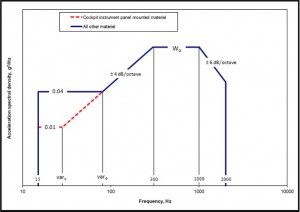This is part five of a series of blog posts concerning the MIL-STD 810 Vibration Section. This blog was written with reference to MIL-STD-810G w/Change 1 dated 15 April 2014. DES has the experience and expertise to help you determine what profiles are appropriate for your product and to run your MIL-STD-810 vibration test. For more information, please check out our Vibration Testing services page and our other MIL-STD-810 vibration testing blog articles:
MIL-STD-810 Vibration Testing Overview
MIL-STD-810: Vibration Testing Category 4 – Truck/Trailer – Secured Cargo
MIL-STD-810: Vibration Testing Category 9 – Aircraft – Helicopter
MIL-STD-810: Vibration Testing Category 7 – Aircraft – Jet
MIL-STD-810: Vibration Testing Category 8 – Aircraft – Propeller
Category 12 of Method 514.7 Vibration testing begins the operational vibration exposure section (Annex D) of Method 514.7 and defines the tests necessary for products to operate in and survive vibration environments. Category 12 outlines the vibration environment for products installed in fixed wing jet aircrafts (except if said product is engine-mounted). The vibration environment of installed products in fixed wing jet aircrafts is made up of 4 components; airframe structural response, jet noise and aerodynamically induced vibration, cavity noise induced vibration, material induced vibration.
Airframe structural response dynamics are from the response of flexible airframe structures to typical events such as take-off and landing impacts. Jet noise and aerodynamically induced vibration are determined primarily by altitude and speed where jet noise dominates over subsonic speeds at lower altitudes and transonic speeds at higher altitudes. Aerodynamically induced vibration typically dominates at transonic speeds at lower altitudes and supersonic speeds at any altitude. Cavity noise induced vibration is caused by openings in the aircraft skin where external airflow is allowed to pass through.
As you can imagine, the fluctuating pressures produce turbulent airflow causing vibration to the surrounding parts. Finally material induced vibration is any vibration that is created from surrounding product operation. Examples are motors, pumps and gear boxes.

Figure 1 illustrates the typical vibration profile for products installed in fixed wing jet aircraft. The parameters of the plot are calculated using equations outlined below in Table 1. Typical test durations are 1 hour per axis for endurance testing or 5 to 10 minutes per axis to demonstrate that products will operate acceptably in these environments.

To learn how Delserro Engineering Solutions can help you test for exposure issues in your product through our vibration testing services, or our range of dynamic testing services, please contact us today.